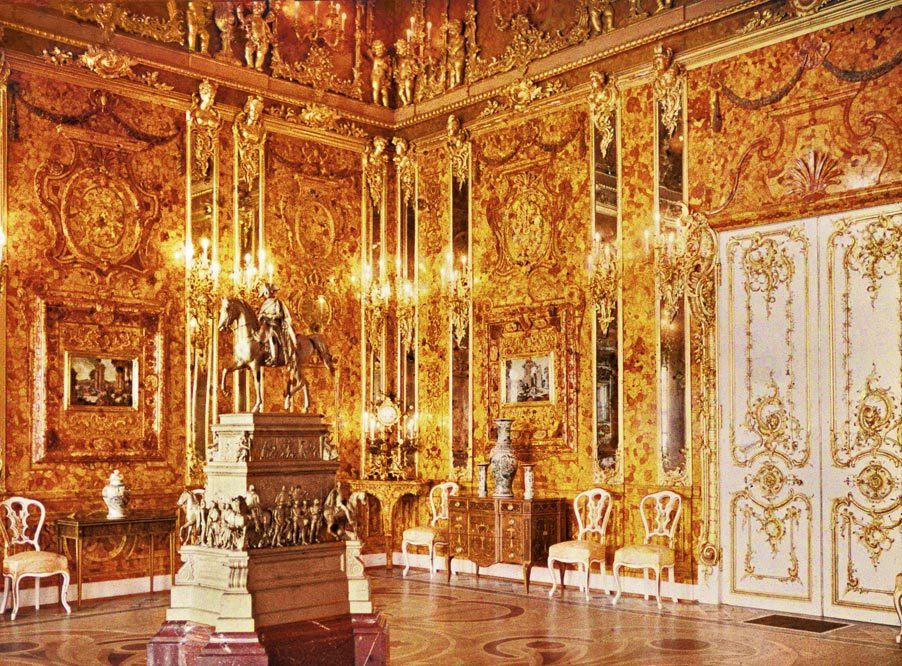The Amber Room is surely one of the most original and – since its disappearance in 1944 in the aftermath of the WWII – mysterious of the world’s works of art. The exquisite room made of several tons of the golden tree resin – the lightest gem in the world – is often referred to as the “Eighth Wonder of the World”.
The Amber Room was a series of large wall panels inlaid with several tons of masterfully carved high-quality amber, long wall mirrors and four Florentine mosaics. The amber, which covered three walls, was arranged in three tiers. The central (middle) tier consisted of eight large, symmetrical vertical panels. Four of them contained pictures made of semiprecious stones like quartz, jasmine, jade and onyx, executed in the 1750s in Florence using the Florentine mosaic technique according to designs by the artist Giuseppe Dzokki, and depicting five senses: Sight, Taste, Sound, Touch and Smell.
The distance between the large panels was occupied by mirrored pilasters. The lower tier of the room was covered in square amber panels. One of the corners contained a small amber table on an elegantly turned leg. The room’s furnishings consisted of inlaid wood commodes of Russian origin, and a vase of Chinese porcelain.
In addition, one of the most valuable collections of amber objects created in the 17th and 18th centuries by German, Polish and Russian masters was housed in the room’s glass-covered display cases.
The history of the Amber Room dates back to the very beginning of the 18th century, when Andreas Schluter, the chief architect of the Prussian royal court, had the idea of using amber, a material never before used for interior decoration, to complete one of the rooms of the Great Royal Palace in Berlin during the reconstruction under Frederick I.
The work started in 1701 and continued until 1713 with the help of the best German, Swedish, and Dutch amber masters, when the old king died, and the new Prussian King – Frederick Wilhelm I – came into power. He was not interested in the beautiful and exquisite Amber Room, the rumors of which had by that time reached Russia.
In 1716, Russian Tsar Peter I visited Berlin, admired the amber masterpiece, and Frederick Wilhelm I asked Peter the Great to accept the unusual room as a diplomatic gift. The Russian Tsar’s return present was no less original: 55 choice grenadiers. After a long shipping time and complex route (Berlin-Koenigsburg-Memel-Riga-St.Petersburg) the Amber Room finally reached its destination. The boxes were unpacked but the Russian masters did not manage to reconstruct the Amber Room, and it was for some time forgotten.
When Empress Elizabeth started reigning in the 1740s, she commissioned her chief architect, Bartolomeo Francesco Rastrelli, to use the amber for decoration of one of the rooms of the Winter Palace. The room was too large, and the architect used mirrored pilasters and painted additional panels in “fake amber”. In 1755, the Amber Room was transferred to the Catherine Palace in Tsarskoje Selo where the new room was to be constructed.
The room in the Palace was again too large for the Amber Study, and the amber parts were reassembled on the walls alternating with pilasters and mirrors. The places where the amber was missing, were painted in “fake amber” and afterwards replaced with real amber panels. By 1770 the Amber Room was complete. However the amber was damaged by the stove heating and temperature changes, and the room was restored three times: in 1833, 1865, and in the 1890s. The next restoration was to take place in 1941.
In the beginning of WWII it was decided not to evacuate the fragile Amber Room, and instead preserve the treasures on the walls of the Palace disguised by the paper, gauze and cotton. But is it possible to hide several tons of amber under paper? The German troops dismantled the panels and sent them to Koenigsburg, where the Room was displayed in one of the halls of the Koenigsburg Museum. In 1944, as the German Army retired, the Amber Room was dismantled again, and taken into the unknown direction. According to different resources, the Amber Room was (a) destroyed by the Allies’ bombing; (b) buried in a silver mine not far from Berlin; (c) hidden on the shores of the Baltic Sea.
Nothing has been found yet, though parts of the mosaics appeared in the 1990s in Germany. Thus, the 50-year-old mystery of Amber Room is still alive.
The estimated value of the vanished Amber Room is more than $100 million.
Courtesy of German Culture.
The photo shows the only surviving color image of the Amber Room. The image dates from 1917 and was made on autochromes by Andrei Andreevich Zeest.
